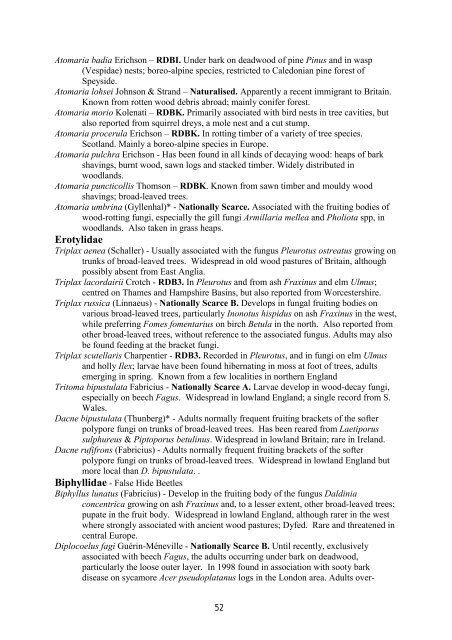Crustacea: Copepoda - Cerambycoidea.com
Crustacea: Copepoda - Cerambycoidea.com
Crustacea: Copepoda - Cerambycoidea.com
You also want an ePaper? Increase the reach of your titles
YUMPU automatically turns print PDFs into web optimized ePapers that Google loves.
Atomaria badia Erichson – RDBI. Under bark on deadwood of pine Pinus and in wasp<br />
(Vespidae) nests; boreo-alpine species, restricted to Caledonian pine forest of<br />
Speyside.<br />
Atomaria lohsei Johnson & Strand – Naturalised. Apparently a recent immigrant to Britain.<br />
Known from rotten wood debris abroad; mainly conifer forest.<br />
Atomaria morio Kolenati – RDBK. Primarily associated with bird nests in tree cavities, but<br />
also reported from squirrel dreys, a mole nest and a cut stump.<br />
Atomaria procerula Erichson – RDBK. In rotting timber of a variety of tree species.<br />
Scotland. Mainly a boreo-alpine species in Europe.<br />
Atomaria pulchra Erichson - Has been found in all kinds of decaying wood: heaps of bark<br />
shavings, burnt wood, sawn logs and stacked timber. Widely distributed in<br />
woodlands.<br />
Atomaria puncticollis Thomson – RDBK. Known from sawn timber and mouldy wood<br />
shavings; broad-leaved trees.<br />
Atomaria umbrina (Gyllenhal)* - Nationally Scarce. Associated with the fruiting bodies of<br />
wood-rotting fungi, especially the gill fungi Armillaria mellea and Pholiota spp, in<br />
woodlands. Also taken in grass heaps.<br />
Erotylidae<br />
Triplax aenea (Schaller) - Usually associated with the fungus Pleurotus ostreatus growing on<br />
trunks of broad-leaved trees. Widespread in old wood pastures of Britain, although<br />
possibly absent from East Anglia.<br />
Triplax lacordairii Crotch - RDB3. In Pleurotus and from ash Fraxinus and elm Ulmus;<br />
centred on Thames and Hampshire Basins, but also reported from Worcestershire.<br />
Triplax russica (Linnaeus) - Nationally Scarce B. Develops in fungal fruiting bodies on<br />
various broad-leaved trees, particularly Inonotus hispidus on ash Fraxinus in the west,<br />
while preferring Fomes fomentarius on birch Betula in the north. Also reported from<br />
other broad-leaved trees, without reference to the associated fungus. Adults may also<br />
be found feeding at the bracket fungi.<br />
Triplax scutellaris Charpentier - RDB3. Recorded in Pleurotus, and in fungi on elm Ulmus<br />
and holly Ilex; larvae have been found hibernating in moss at foot of trees, adults<br />
emerging in spring. Known from a few localities in northern England<br />
Tritoma bipustulata Fabricius - Nationally Scarce A. Larvae develop in wood-decay fungi,<br />
especially on beech Fagus. Widespread in lowland England; a single record from S.<br />
Wales.<br />
Dacne bipustulata (Thunberg)* - Adults normally frequent fruiting brackets of the softer<br />
polypore fungi on trunks of broad-leaved trees. Has been reared from Laetiporus<br />
sulphureus & Piptoporus betulinus. Widespread in lowland Britain; rare in Ireland.<br />
Dacne rufifrons (Fabricius) - Adults normally frequent fruiting brackets of the softer<br />
polypore fungi on trunks of broad-leaved trees. Widespread in lowland England but<br />
more local than D. bipustulata. .<br />
Biphyllidae - False Hide Beetles<br />
Biphyllus lunatus (Fabricius) - Develop in the fruiting body of the fungus Daldinia<br />
concentrica growing on ash Fraxinus and, to a lesser extent, other broad-leaved trees;<br />
pupate in the fruit body. Widespread in lowland England, although rarer in the west<br />
where strongly associated with ancient wood pastures; Dyfed. Rare and threatened in<br />
central Europe.<br />
Diplocoelus fagi Guérin-Méneville - Nationally Scarce B. Until recently, exclusively<br />
associated with beech Fagus, the adults occurring under bark on deadwood,<br />
particularly the loose outer layer. In 1998 found in association with sooty bark<br />
disease on sycamore Acer pseudoplatanus logs in the London area. Adults over-<br />
52

















